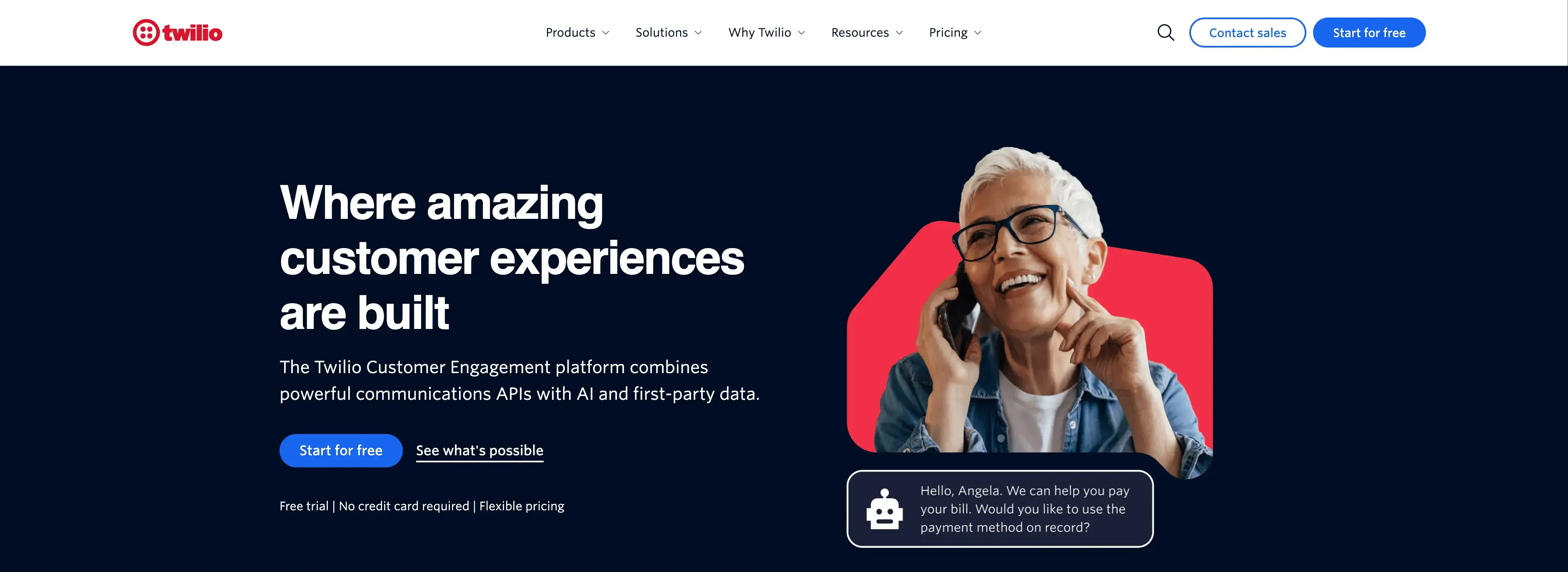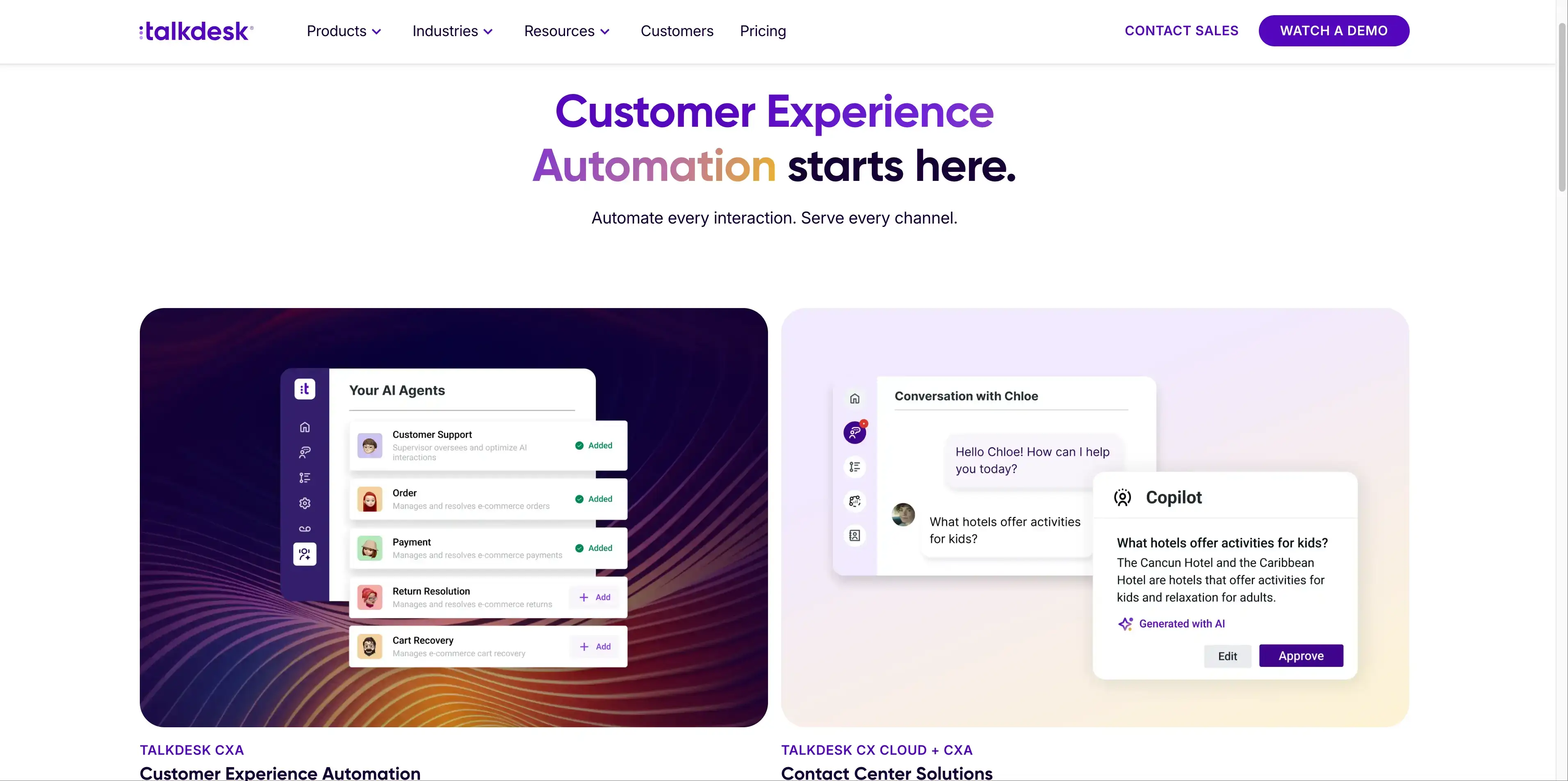Interactive Voice Response (IVR) technology has been widely used in modern contact centers. Since the COVID-19 pandemic, the IVR in contact centers has grown explosively.
According to the report from Business Research Insights, the global IVR market size was estimated at $5.5 billion in 2025 and is projected to reach $9.91 billion by 2034, at an average annual rate of 4.49%.
Do you want to improve your customer interaction efficiency? It’s high time to integrate IVR into your contact center. In this article, we’ll walk you through everything you need to know about the IVR contact center.
What Is Interactive Voice Response (IVR)
Interactive Voice Response (IVR) is an automated voice interaction system. It allows businesses to greet customers through automated menu options using voice or keypad inputs. With this system, customers can be quickly directed to appropriate resources without human intervention.
IVR technology can be seen everywhere in real life. For example, you may be guided to press one for customer service, press two for returns, or do other similar things when communicating with contact centers.
To put it simply, an IVR system can assist call centers by diverting incoming calls, resolving customer inquiries instantly, and freeing up agents from routing tasks. It has been commonly used in all walks of life, such as:
- E-commerce
- Retail
- Delivery
- Healthcare
- Education
- Travel and hospitality
- Telecommunications
How Does an IVR System Work
An IVR system works by combining telephony and automation, building a direct connection between computers and phone systems via Computer Telephony Integration (CTI).
In simple terms, IVR can navigate a customer to the proper department or support agent using pre-recorded voice prompts or menu options. It helps businesses manage call centers efficiently by optimizing call routing and reducing human service costs.
Here’s a typical IVR interaction flow. Let’s see how it works:
1.Your contact center receives a call from a lady.
2.The IVR system greets her and provides a set of voice prompts, like “Press 1 for checking balance” or “Press 2 for human support”,
3.Your contact center answers her using voice commands or keypad.
4.The customer may be guided to the appropriate human support or self-serve based on the inputs.
3 Main Types of IVR Systems
IVR systems have gone through a long period of development and have now evolved into more advanced levels of interaction. In modern contact centers, the following 3 types of IVR systems are commonly used.
IVR systems have gone through a long period of development and have now evolved into more advanced levels of interaction. In modern contact centers, the following 3 types of IVR systems are commonly used.
- Self-Service IVR: It is the most basic form that enables customers to resolve common queries by themselves. With automated menu options, customers can quickly access essential services, such as checking account balances, resetting passwords, or canceling reservations.
- Cloud or Hosted IVR: This cloud-based IVR system removes the need for on-premises hardware configuration, reducing upfront costs and operational complexity of a contact center. It means that call centers can deploy, update, or expand the IVR system quickly without extensive IT resources.
- AI-Powered IVR: It is a completely new model that incorporates AI technology and Natural Language Processing (NLP). It can analyze customer emotions and intentions to offer precise responses. Different from rigid menus, customers can get natural and conversational interactions that feel more human.
Benefits of IVR in Contact Centers
A well-integrated IVR system boasts a lot of benefits, from reducing wait time to automating routing tasks. They help businesses optimize operations, improve service efficiency, meet customers’ evolving needs, etc. Let’s have a look at how IVR improves your contact centers.
Reduce Operational Costs
Since the IVR can handle lots of calls at once, a business doesn’t have to employ extra staff to keep up with surges in call volumes, reducing labor costs. Besides, some cloud-based and AI-driven IVR systems can minimize operational costs because they don’t need on-premises hardware configuration.
Boost Efficiency and Productivity
IVR systems greatly boost customer service efficiency by automatically handling repetitive tasks, deflecting incoming calls, and simplifying workflows. These automated services reduce the need for live agents, making them focus on more complex or personalized customer service.
Offer 24/7 Customer Support
With 24/7 service support, IVR systems have a profound influence on improving customer experience. They can keep operating around the clock with pre-recorded voices, whether during the day or in the middle of the night, or during a holiday weekend.
An IVR contact center enables customers to access some automated services without waiting time, such as checking account balances, making payments, viewing historical orders, and so on.
Improve First Contact Resolution Rates
IVR systems offer self-service options to quickly help customers access the information they need, which improves the first contact resolution rates (FCR) while keeping customers satisfied.
Moreover, IVR achieves this by routing calls to the most appropriate agent, answering common questions, or collecting valuable customer feedback. It can also integrate with other technologies, like CRM, to resolve more customer issues on the first contact.
Insight Customer Data
IVR systems can help you collect valuable customer data, such as call duration, first resolution rate, call spikes, etc. With the analytics of this data, you can find which areas need to be improved and how to do that. For example:
Challenges of Interactive Voice Response
An Interactive Voice Response (IVR) system also faces many challenges while offering potential benefits. These challenges can be solved in the following aspects. Let’s have a detailed look at them:
Complex Menu Navigation
Problem: Overly complex and unclear menu navigation makes callers feel confused, leading to frustration, increased call drops, and even an angry customer.
Solution: Keep your menu options easy and intuitive to navigate. Or you can provide a clear guide to the live agent early in the call.
Lack of Personalization and Human Touch
Problem: Automated handling processes make callers feel impersonal, especially when they have emotional or urgent problems.
Solution: Implement user-friendly and natural voice interaction, or direct callers to live agents when necessary. Meanwhile, offer personalized customer experiences, such as historical interaction records, call ID information checks, etc.
Voice Recognition Issues
Problem: Sometimes an IVR system may fail to understand or respond to customer spoken inputs, it may misdirect the call, or even disrupt the entire interaction, resulting in poor customer experience.
Solution: Introduce high-quality speech recognition technology or optimize the system to recognize extensive voices and accents. Also, you can integrate speech recognition with keypad alternatives and keep training NLP models.
Difficult to Reach a Live Agent
Problem: Some basic IVR systems are hard for customers to connect with a live agent, leading to customer unhappiness and even annoyance.
Solution: Within the IVR system menu, make sure to provide a simple and clear way to connect with a human agent.
Best Contact Center IVR Software in 2025
Now, it’s high time to pick a contact center IVR software. Here, we summarize several popular and highly rated IVR solutions for your contact centers. Let’s have a quick overview of them first.
Note: The price may fluctuate over time or with subscription methods. For specific prices, refer to the official websites of these platforms.
IVR Software | Best for | Features | Pricing |
Zendesk | AI-powered CX | IVR scripting and workflow builder Call routing Omnichannel support 1,800+ apps and tools | $55/agent/month |
Nextiva | Sales and marketing calls | Unified platform for voice Call recording Call routing Agent monitoring | $15/user/month |
CloudTalk | Sales-focused multinational businesses | IVR scripting International phone numbers Analytics and reporting Omnichannel support | $29/user/month |
Twilio | Technical call centers | IVR scripting Integrations Mobile app Call routing | $150/user/month |
Talkdesk | Enterprise contact centers | IVR scripting Call routing Auto-queue callback HD video conferencing | $85/agent/month |
RingCentral | Small businesses | CRM integration Business SMS Cloud phone system Voicemail | $20/user/month |
1. Zendesk
Zendesk is a cloud-based customer service platform that provides scalable and customizable IVR solutions. Whether you are a small business or a large enterprise, the IVR system from Zendesk can easily handle your call volumes and evolve as your business scales.

Pros:
- Easy to deploy into your current system and use
- Flexible and scalable customer support
- Integration with a wide range of third-party apps and tools
- Robust reporting and analytics capabilities
Cons:
- Only provides 14 days of free trial
2. Nextiva
Nextiva’s IVR is also a cloud-based system designed to automatically handle inbound and outbound calls, greatly streamlining business communications. With its IVR systems, businesses can easily build customized call flows, route calls based on various criteria, and integrate with other systems, like CRM, CTI, etc.

Pros:
- Intuitive and easy to navigate
- Robust and responsive customer support
- Affordable for small businesses
- Reliable VoIP service
Cons:
- Limited integrations
- No free trial
3. CloudTalk
As a cloud-based IVR platform, CloudTalk is best for multinational companies, customer services, operations, and IT teams. It enables you to manage customer calls automatically and guide them to the right agent based on pre-defined criteria. Moreover, its international phone numbers allow you to build a local business in multiple countries.

Pros:
- Easy to set up and use
- Strong call management features
- Global phone numbers
- Real-time dashboards and in-depth reporting
Cons:
- Glitched mobile apps
- Limited integrations
4. Twilio
Twilio’s IVR software is suitable for those who want to build and operate a real-time communication platform, especially for call centers with technical expertise. It allows developers to integrate various communication channels directly into apps, such as voice, chat, SMS, email, and video.

Pros:
- Powerful API-first integrations
- Friendly use for developers
- Strong integration capabilities with other systems
- Reliability and global connectivity
Cons:
- Technical expertise required
- Limited built-in features
- Costly
5. Talkdesk
Talkdesk is a cloud-based solution designed for mid-size or large organizations with complex contact center requirements. In addition to all basic calling features, this software provides many AI tools, like virtual assistance, automated quality management, predictive analytics, etc.

Pros:
- Easy to use
- Powerful live dashboards
- Intelligent call routing
Cons:
- No free trial
- Limited communication channels
6. RingCentral
RingCentral’s IVR system automates phone interactions best for small businesses. It is a feature-rich contact center solution, offering call routing, self-service options, and integrations with other tools. It uses touch tone keypad menus or speech recognition to route calls to specific departments.

Pros:
- Handle high call volumes simultaneously
- Comprehensive communication solutions
- High degree of customization
- Affordable
Cons:
- Complex and time-consuming to set up
- Potential costs for advanced features
Bottom Line
Now, here’s the end of this article. I believe that you already know what Interactive Voice Response (IVR) is, including its features, benefits in contact centers, and challenges. If you are struggling to choose the contact center IVR software for your business, just pick one from the above recommendation.
IVR Contact Center FAQ
1. How to set up IVR for contact center?
- To implement an IVR system into your contact center, you need to consider your needs and goals first, and then choose a platform, determine your call flow, record voice prompts, configure the system, test it thoroughly, and then use it.
2. How to choose an effective IVR provider?
To choose an appropriate IVR provider for your call center, you can take the following steps:
- Determine your needs, such as reducing costs or improving service efficiency.
- Evaluate the features and capabilities of your current call centers.
- Focus on user experience.
- Consider the flexibility and security of the provider.
- Evaluate the IVR providers, including their features, reviews, reputations, etc.
3. Does IVR record calls?
Yes, Interactive Voice Response (IVR) systems can record calls. Most contact center solutions provide this feature, allowing a business to record communications between the callers and IVR. These records can be used for various needs, such as training agents, quality assurance, and dispute resolution.
4. What’s the difference between IVR and CTI?
Interactive Voice Response (IVR) is a feature included in Computer telephony integration (CTI) to automatically handle incoming calls and offers self-service menu options, while CTI is a technology that supports agents to take phone calls from their computers.












